Table of contents
- Moto2 designer Kalex in portrait Where does the success come from?
- In 2010 Kalex didn’t get a single point
- Moto2 champ Zarco switched to Kalex in 2015
- Kalex frame is softer and more forgiving
- Differences in the Moto2 are very small
- Sam Lowes also changes sides
- Engineers get a lot of feedback
- Kalex chassis costs 65,000 euros
- Tires are everything
- Suter leaves in 2016
- Too many pilots lost to Kalex
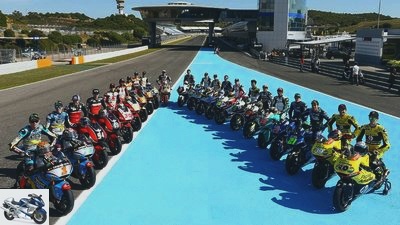
2snap
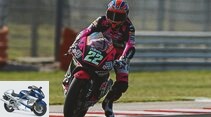

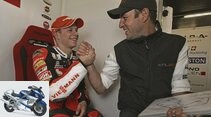

11 pictures

2snap
1/11
The Briton Sam Lowes won a Grand Prix in Austin in 2015 with the Speed Up-Moto2. However, he only fought for the last points in other races. In 2016 Lowes also switched to a Kalex.
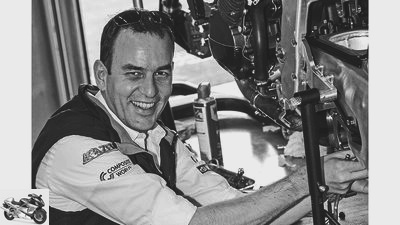
2snap
2/11
Alex Baumgartel: “Our dominance surprises me and is not good, because competition motivates”.
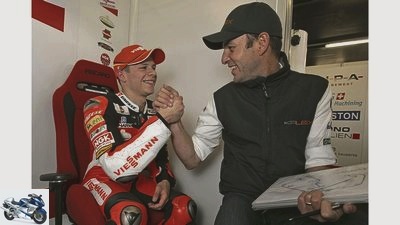
2snap
3/11
Stefan Bradl 2011 with Alex Baumgartel. For the Upper Swabians from Kalex, the collaboration with the Bavarian from Zahling in his world championship year was the breakthrough as a chassis builder in the Moto2 World Championship.
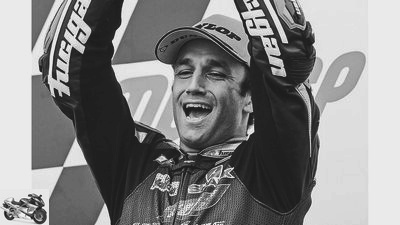
2snap
4/11
Johann Zarco: “Dunlop today has harder compounds that simply work better on the Kalex than on other Moto2 bikes”.

2snap
5/11
Thanks to the Kalex chassis, the Dunlop standard tires and the WP fork, the wild rodeo insoles à la Marc Márquez in Moto2 are now a thing of the past. Johann Zarco’s precise driving style dominates.
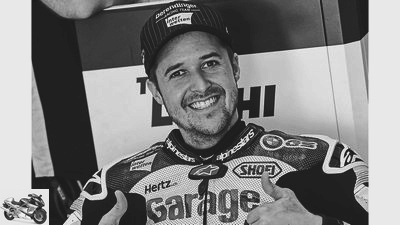
2snap
6/11
Tom Luthi: “You don’t need a Kalex, but you can use it to delete a variable in your head”.
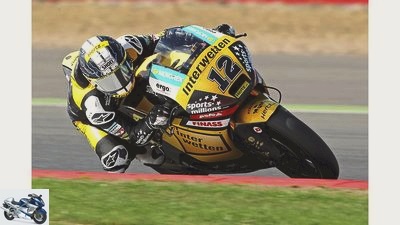
Tim Keeton, 2snap
7/11
Tom Luthi 2013 on a Suter at the Grand Prix in Silverstone. The Swiss driver drove the chassis from Turbenthal in Switzerland for four years and won four races. He won the 2015 French Grand Prix in Le Mans with the Kalex.
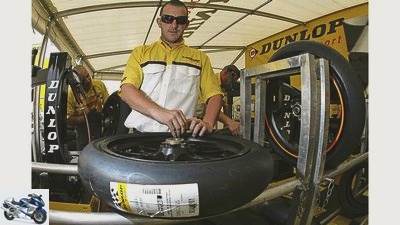
2snap
8/11
The Kalex superiority also has an impact on the Dunlop standard tires. Most of the feedback comes from Kalex drivers – and they have different demands than the other pilots.
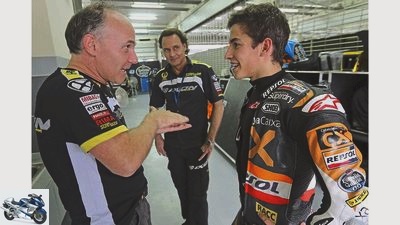
2snap
9/11
Frame specialist Eskil Suter (left) has already built many chassis, including the Moto2 world champion motorcycle by Marc Márquez in 2012.
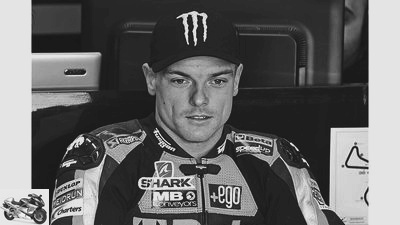
2snap
10/11
Sam Lowes: “It’s their own fault that almost only Kalex is now a winner”.
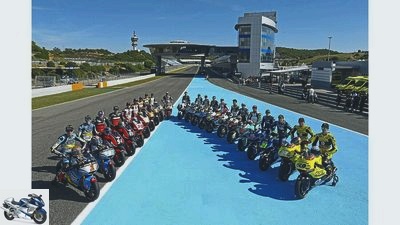
2snap
11/11
Kalex never wanted sole rule. Nevertheless, the German designer turned the Moto2 class into a monopoly world championship.
Sports & scene
Moto2 designer Kalex in portrait
Moto2 designer Kalex in portrait
Where does the success come from?
Content of
In 2015, the German designer Kalex transformed the Moto2 class into a monopoly world championship. Kalex itself had never intended to be sole power. PS got to the bottom of the cause.
Mat Oxley, Uwe Seitz
01/12/2016
When the GP promoter Dorna created the Moto2 as a new class in 2010, the aim was to create the same conditions for the hungry young riders – with standard engines from the Honda CBR 600, standard tires from Dunlop as well as electronics, fuel and even clutches as if from a single source. The only battlefield for engineers was the chassis. And so, before the premiere season, eight manufacturers set about building frames and swingarms for the middle Grand Prix class.
Buy complete article
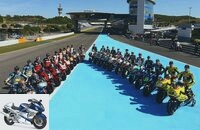
Moto2 designer Kalex in portrait
Where does the success come from??
10 pages) as PDF
€ 2.00
Buy now
In that first year the competition for the best chassis was extremely tough. Five different manufacturers were represented in the top ten: Moriwaki, Suter, Speed Up, Motobi and FTR – but not a single Kalex. How times change Because in 2015 Moto2 presented itself as a kind of Kalex Cup. The German chassis manufacturer dominated the series. Only one of the top 14 riders drove another make, and only one non-Kalex rider was able to win at least one of the 18 races: Sam Lowes with his Speed Up-Moto2. In 2016 he will also be promoted Kalex around.
In 2010 Kalex didn’t get a single point
How could that happen? Is the Kalex package really that dominant or are other forces at work? The Kalex story is impressive. The construction company based in Bobingen near Augsburg emerged from the Holzer Group, which is very successful in car racing. But the employees Alex Baumgartel and Klaus Hirsekorn were also motorcycle enthusiasts. In 2008 the two built their first chassis for a motorcycle that was powered by an RSV Mille-Twin, and that year they presented it to the general public for the first time at the PS-TunerGP. The second chassis was then for Moto2, in the premiere year 2010. Only the Sito Pons team dared to start the Grand Prix with a completely blank slate.
Kalex didn’t get a single point that year. But in the following season they won the world title with Stefan Bradl. That success changed everything. In 2012 Kalex already had 12 drivers who scored points, the following year 13, then 14 and last season 19. Two thirds of the Moto2 field drove Kalex. Suter, on the other hand, winner of the first Moto2 race in Qatar in 2010, went in the opposite direction. There were 14 points drivers for the Swiss in 2010, in 2015 just one more. There will be no more in 2016, because Suter has now given up the Moto2 fight against Kalex. The situation is similar with the other designers. Fewer and fewer drivers are getting on Speed Up, while the first world champions Moriwaki, as well as Motobi, FTR and Harris, have long since left with the advance of Kalex. The Bobinger eventually won four of the last five Moto2 World Championship crowns.
Moto2 champ Zarco switched to Kalex in 2015
Suter’s most loyal driver was the Swiss Tom Luthi, who won four races for the brand from 2011 to 2014. But then he also made a decision in favor of Kalex. According to the motto: If you can’t beat them, you have to go along with them. “I don’t think you need a Kalex to win. You can still win with a Suter or a Speed Up, ”says Luthi, who became world champion in 2005 on a 125cc. “But in 2014, my team and I decided to continue with the bike that the others ride too. So you can leave out a variable in your head and concentrate on your job. “
The reigning Moto2 world champion Johann Zarco followed a similar path as Luthi. After two unsuccessful years with Suter, he switched to Kalex in 2015 and won eight races. “Firstly, I wanted to sit on a winning bike and, secondly, we noticed that Dunlop was putting harder compounds in the tires – the Kalex works much better with harder tires,” explains the Moto2 champ, who wants to defend his 2016 title. “The third reason is that the Kalex is the best bike because you feel good on it on every track. The bike simply works over a larger adjustment range. Even if it doesn’t fit one hundred percent, you can still be fast with it and not struggle with grip as much. Your head is much clearer. We think that a more sensitive bike works better with the right setup, but you have to think about the whole championship, you need a bike that is always good. “
Kalex frame is softer and more forgiving
This is the theory of the last few years: A perfectly adjusted Suter is the fastest Moto2 bike ever, but the Kalex frame is softer and more forgiving. That’s why it works for most riding styles, routes and grip conditions. Of course, Kalex doesn’t reveal any details, but the frame probably has a bit more flex. In addition, it goes without saying that every reasonably intelligent rider will choose a motorcycle that is 90 percent effective on all routes than one that only fits 100 percent on three or four slopes and only fits 80 on the other.
“When you’ve found a perfect setup with the Suter,” explains Luthi, “the bike is much more precise, more like a real GP bike. But finding exactly this setup is damn hard. The Kalex is not as precise and it moves more, but you can still go very quickly with it. “
Differences in the Moto2 are very small
Kalex co-founder Alex Baumgartel is almost embarrassed by the triumph of his company. “We still feel like rookies in this business because we started very small just six years ago,” he says, amazed at the success. “It’s so tight in this class that it’s very difficult to explain why our chassis is the better one. Most drivers say ours is softer than Suter’s, while others say exactly the opposite, which we can hardly believe. We never examined the Suter for rigidity or geometry, because you just have to go your own way. “
“We were lucky with Stefan Bradl. That was our turbo drive, ”says Baumgartel. “Fortunately, we found the right direction with him. If you don’t have the right driver at the right time, you will get lost. Especially in Moto2, where the differences are so small. It’s like bobsledding; everyone has the same drive, so there is no difference in performance. As if you had no engine at all. The first three only ever separate hundredths. If the fairing is fly-free, you might get a thousandth more on the straight. “
Sam Lowes also changes sides
But if the chassis are so similar, where does the Kalex dominance come from? Maybe the bike works better on most tracks, but there are more aspects to it. Most motorcycle racers are not normal people. They have a superhuman belief in themselves. So if a competitor wins on another bike, they immediately believe that they will win on that bike too. It doesn’t even occur to them that the other could be better. If you thought so, you could stop right away.
As Kalex started winning races, more and more riders wanted the frame. And so Kalex won even more races. Although over time, of course, more and more drivers didn’t win a race on Kalex. “It’s like with the lemmings,” laughs Baumgartel at the phenomenon. Now Sam Lowes also changes sides, although he feels a remorse. “It’s the riders’ fault that it turned out like this,” smiles the Austin GP winner, who rides a Gresini-Kalex in 2016 before going into MotoGP with Aprilia the following year. “If our setting was right, the Speed Up was just as good as the Kalex. But 99.9 percent of the season it wasn’t an advantage to be on the bike because our setup window was much narrower than Kalex’s. It’s not necessarily better, but if you don’t have to try so much, it’s a lot better for your confidence and you can work on yourself more freely. One weekend my bike was just great and the next I had no chance at all. “
Engineers get a lot of feedback
But that was often the case in racing. In the 1990s everyone wanted a Honda NSR 500 on Michelin tires – that was the winning combination. But if someone was lucky enough to get their hands on something like that, there was of course still no guarantee of success.
It is of course an advantage for a manufacturer if so many fast guys use your product: the engineers get a lot of feedback from all kinds of drivers with different driving techniques and styles. This allows you to develop your bike much faster and more effectively. Suter had to deal with the opposite: You didn’t have a pilot in the top 20 in 2015. So where should the dedicated feedback come from?
Kalex chassis costs 65,000 euros
“Speed Up struggled because the only feedback came from me,” says Lowes. “A lot of good drivers sit on Kalex and they have the best information. Dunlop is also developing in that direction because that’s where most of the drivers are. Dunlop engineers always hear their comments. In addition, a lot depends on the teams and how they work. In 2014 Mika Kallio was so damn fast on the Marc VDS Kalex, and in 2015 on the Italtrans-Kalex he didn’t tear anything. “
A Kalex chassis costs 65,000 euros. The ruble has to roll pretty well at Baumgartel? But he says no. “I invested all my money in the Moto2 project. Really everything. But today I have less on the bench than I did before I fell victim to the motorcycle virus. In auto racing, salaries are an industry standard. Here the payments are smaller. But that balances out when you have a passion for it. When our dominance took shape, I was actually against it because you need the motivation to fight your competitors. We’re not here to just get rich. If that were the case, we would do other jobs. Besides, we don’t know how long this will last. You can get in quickly, but also quickly out again. All I have to do is look at the competitors. “
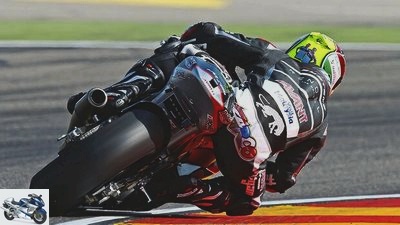
2snap
Thanks to the Kalex chassis, the Dunlop standard tires and the WP fork, the wild rodeo insoles à la Marc Márquez in Moto2 are now a thing of the past. Johann Zarco’s precise driving style dominates.
Baumgartel is right, and we find a good example of this in the chassis. Until recently, Ohlins completely dominated this topic in Moto2, similar to MotoGP. But in Moto2 there was a real migration of the top riders to the KTM subsidiary WP from 2014, with which Zarco, Alex Rins and also Tom Luthi ride.
Amazingly, as a new Kalex customer, Zarco won his world title in 2015 on a 2014 chassis. Which shows that Kalex has been working very well for some time. In fact, there have been a lot of updates to the frame in the first few years but almost none lately. “Now we have less and less,” confirms Baumgartel. “We started with two wings last season. But since everyone wanted to build the right feeling in the preseason, hardly anyone tested it until Takaaki Nakagami finished third in Misano. Its soft rear tire was still in very good condition at the finish. Suddenly everyone said, okay, maybe we should try the swing arm after all. ”Lemmings!
Tires are everything
Paradoxically, standard tires ensure that the races are primarily about the tires. Not like in the past, when the teams were free to choose which tire would work for them. When there was still an open competition among tire manufacturers, the skins were developed in such a way that they fit the individual bikes. Today the bikes have to be developed for the standard tire, i.e. for Dunlop in Moto2 and Moto3, until 2015 for Bridgestone in MotoGP, from now on for Michelin. This can be easy or difficult, depending on the bike, the rider and the engineers. But the tires are not constant either, because they change from year to year and often from race to race.
In 2015, Dunlop’s Moto2 tires required a change in the balance of motorcycles, driving style and setup. “In 2015 the rear tire obviously had more grip, while there was less grip in the front,” says Kalex boss Alex Baumgartel. “The grip balance shifted significantly backwards, but the drivers pushed even more over the font.”
Many riders then felt that the WP fork worked better with the 2015 front tire, and everyone wanted this fork. However, this package required the drivers to turn much more precisely into the corners.
And that in turn explains why Moto2 style is much smoother today than it was in Marc Márquez’s time. The Zarco style is evidence of this. Instead of the wild, rolling rodeo of Márquez 2012, it is now about centimeter-precise smoothness.
Suter leaves in 2016
2015 was the end point for Suter. The brand, which won the title with Márquez in 2012, scored only 20 designer points last season (Kalex: 445). There were big plans to fight back in 2016 – with a completely new bike with redirection (a kind of upside down CBR 600 system) and a larger adjustment range on the chassis. This should allow the bike to be better matched to the Dunlops in all situations.
Nevertheless, Suter has now canceled his Moto2 commitment for 2016 because it did not succeed in getting one of the top riders enthusiastic about the motorcycle. The problem was simple: no rider wanted to switch from Kalex to Suter before the bike could prove it was better. But if Suter doesn’t get a top driver, nothing will come of it. Lemmings!
Too many pilots lost to Kalex
Suter engineer Dominique Langouet is appalled by the company’s decision to simply put the motorcycle in the corner. “70 percent of the bike is completely new,” he says. “On our 2015 motorcycle, we were able to vary the wheelbase by 15 millimeters. With the new Suter it is 30 millimeters. We tested the bike with Dominique Aegerter and the results were very good. Rear traction has improved tremendously. With the larger wheelbase variable, we should also get the weight distribution perfect for every type of driver, every route and the tires. “
Langouet also admits that Suter lost many drivers to Kalex because they made too much policy with the drivers, in which only a few selected teams got good parts, others not. “Maybe we weren’t fair enough,” said Langouet. But he also agrees with Baumgartel’s Lemming theory: “It’s the same in Moto3. At first Honda wasn’t at a good level and everyone wanted a KTM. Now Honda is fully involved and everyone suddenly wants one – although you can win with both models. ”Good for Kalex, bad for Suter – at least at the moment.
Related articles
-
Report: Portrait of the Ducati works driver Cal Crutchlow
Wood 11 pictures Gold and Goose Photography 1/11 Someone like Cal Crutchlow spends the whole year flying around the world in business class, puts a…
-
Portrait of designer Uwe Schneider
Siemer 27 pictures Siemer 1/27 Siemer 2/27 Siemer 3/27 Siemer 4/27 Siemer 5/27 The engine and transmission were specifically and very successfully…
-
Portrait of Moto3 rider Maria Herrera
2snap 39 pictures 2snap 1/39 Maria Herrera in Moto3 in Aragon, 2013. 2snap 2/39 Maria Herrera in Moto3 in Motegi, 2016. 2snap 3/39 Maria Herrera in Moto3…
-
German riders in the Moto2 World Championship 2016
2snap Sports & scene Motorsport German riders in the Moto2 World Championship 2016 German riders in the Moto2 World Championship 2016 Grand with three…
-
2snap Sports & scene Portrait Troy Bayliss Portrait Troy Bayliss Three-time Superbike World Champion Troy Bayliss Content of In 2008, three-time…
-
Mick Doohan and Casey Stoner in portrait
2snap Sports & scene Mick Doohan and Casey Stoner in portrait Portrait: Comparison Mick Doohan / Casey Stoner The MotoGP riders from Australia Content of…
-
Portrait of US collector Fred Mork
Blacksmith 27 pictures Blacksmith 1/27 The similarity between human and … Blacksmith 2/27 Blacksmith 3/27 Tons of story (s): whether model kits,…
-
2snap 6th pictures Friedemann Kirn 1/6 Toni Bou has already won 20 world titles in the trial. Friedemann Kirn 2/6 Superstar without special requests -…
-
Scene: Portrait of Ferry Brouwer
Siemer Sports & scene Scene: Portrait of Ferry Brouwer Scene: Portrait of Ferry Brouwer To ask! Content of He was a mechanic for greats like Phil Read…
-
Photo: 2snap 19th pictures 2snap 1/19 The title went to Stefan Bradl. 2snap 2/19 Marc Márquez began riding motorcycles at the tender age of five. 2snap…